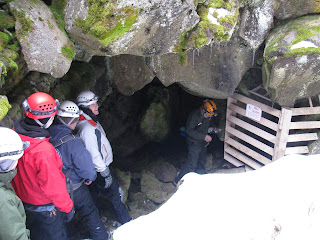Last summer, I had the amazing opportunity to take a ranger guided tour into Fern Cave inside Lava Beds National Monument in Northern California. While I on that trip, I learned of another guided cave tour offered during the winter months into an Ice Cave at the other end of the park. Upon mentioning this trip to some friends, several were interested in joining me, but due to the hyper-sensitive cave environment, only six visitors are allowed per week during the winter months, making the tour reservations a rare and highly-sought commodity. Luckily, with some coordination, we were able to secure reservations on our fourth try.
The drive to Lava Beds is about four hours from Reno and to make our 1:00 PM scheduled tour time, we left about 7:00 AM to provide some buffer. Not knowing what the road conditions would be like, we opted to take a pair of jeeps. Van, Dawson and Bill in Van's Jeep and Nate and I in my jeep. We arrived at the park visitor center and checked in with the rangers, but still having an hour or so before our adventure, we decided to visit a couple of the smaller caves accessible via cave loop just behind the visitor center. While this was the first time at this park for all of my companions, it was my third visit and my second to some of these lava tube caves. Still though, the formations are quite interesting and one would be hard-pressed to get bored here, even upon visiting for the 100th time.
As tour time approached, we headed back to the visitor center and followed the rangers up to the cave entrance. We put on our hard hats, head lamps, knee pads and warm layers as recommended by the rangers, before climbing on the loose volcanic rocks through a small hole and then to the locked gate over the cave entrance.
Immediately upon entering the cave, we were forced to climb down a steep permanent ladder about 20 feet to the rocky floor below. Head lamps on, we immediately notice our second obstacle - a frozen slide. The next section is a perfectly smooth, but un-level descent down about 50 feet. Holding onto the ropes secured on the other end, we each slide down the ice in turn. It was actually kind of fun.
As we collect ourselves, we encounter the first of the intricate and otherworldly ice formations, for which the cave is known. Ground water seeping through cracks in the basalt cave walls and ceiling has formed a number of icicles on the walls - some of which are 10+ feet tall and have formed a more solid mass spanning from ceiling to floor. Drops from the ceiling have also formed what can only be described as ice stalagmites rising 3 to 5 feet and in some cases, in slightly staggered and tiered formations, as if the source of the water droplets shifted ever so slightly over time. The ice is crystal clear. It's beautiful.
We continue further into the cave and are forced to navigate through another hole in the floor into what used to be the red room entrance. However, as more ice has formed, the entrance has been frozen shut by a frozen pond. Tall stalagmites and stalactites reach for each other over the ice-filled room, which to the eye appears to be filled with water, but upon further examination is clearly ice.
We climb back out of the area and move onto the next section of the cave. Each room, we move into is more spectacular than the last. This one boasts a floor-to-ceiling ice column about 2 feet in diameter. We take a few pictures and move on.
Next, we must negotiate our way around one of the larges ice formations in the cave, which appears to be a frozen waterfall busting through from the sections above us and spilling out into our level of the cave, but frozen in time. The ice is perfectly clear and perfectly slick, making the maneuver somewhat challenging, but all make it.







No comments:
Post a Comment